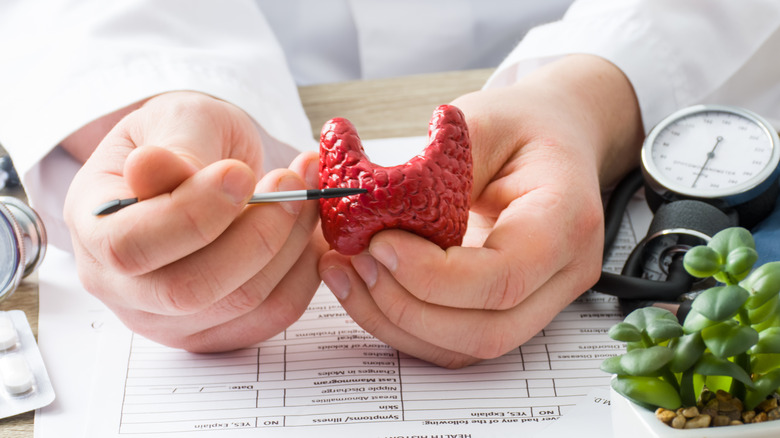How To Identify The Different Types Of Lymphocytic Thyroiditis
The thyroid might be a small component of the human body, but it's an important one. When it's not functioning properly, it can cause a myriad of problems. Thyroiditis, an umbrella term for any form of inflammation of the thyroid, is responsible for a number of disorders that can present in different ways (via American Thyroid Association). One of these disorders — lymphocytic thyroiditis — has different types within it, which have a few distinguishing characteristics.
The thyroid is a butterfly-shaped gland at the front of the neck, responsible for making thyroid hormones (via American Thyroid Association). These hormones are critical for bodily functions like staying warm, using energy, and making sure organs like the heart and brain are working properly. When antibodies attack the thyroid and cause inflammation, thyroid cells are damaged, which leads to thyroiditis. This is often considered an autoimmune disorder. While it's not totally clear why this happens, it could run in families, be caused by a viral or bacterial infection, or be due to certain medications.
After this initial inflammation, thyroiditis can take a few different forms. Lymphocytic thyroiditis is an autoimmune disorder identified as a phase of increased thyroid hormone (hyperthyroidism), followed by a phase of decreased hormone production (hypothyroidism) that sometimes becomes chronic (via Verywell Health).
The subtypes of lymphocytic thyroiditis
Some cases of lymphocytic thyroiditis will be short-term and non-permanent, also known as subacute lymphocytic thyroiditis (via Verywell Health). This subacute form has two types: silent lymphocytic thyroiditis and painless thyroiditis. Silent lymphocytic thyroiditis often presents without pain or tenderness in the thyroid, commonly affecting women in the postpartum period. It generally starts around 12-16 weeks postpartum and lasts for a few months, occurring in 5-10% of women who have recently given birth. Symptoms can include thyroid enlargement, and early symptoms of hyperthyroidism (heart palpitations, nervousness, heat intolerance, and diarrhea) are often followed by later symptoms of hypothyroidism (cold intolerance, weight gain, constipation, and fatigue). Painless thyroiditis is similar in nature, except it can affect men and women regardless of whether or not they are postpartum. This is usually hereditary and doesn't require treatment.
In some cases, lymphocytic thyroiditis can become chronic, developing into a condition known as Hashimoto's thyroiditis or Hashimoto's disease (via Verywell Health). This tends to be hereditary and typically affects people aged 30-50 years old. This chronic inflammation can cause permanent damage to the thyroid, leading to hypothyroidism that doesn't go away. As time goes on, more symptoms can occur, including fatigue, weight gain, joint stiffness, depression, dry skin, hair loss, poor memory, and constipation. It's usually treated with medication and monitored closely by a healthcare provider. While it's a lifelong condition, it's possible to return thyroid levels to normal and live with minimal symptoms.


